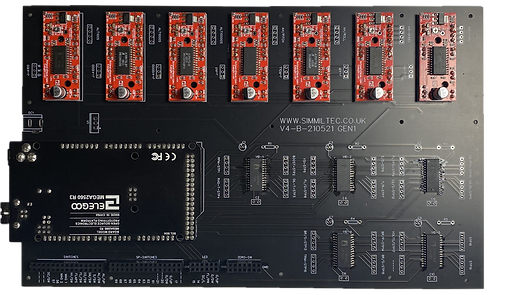STANDARD FLIGHT SIMULATOR INSTRUMENT PANEL
Our standard panels are ready for you to mount and connect very quickly, All Spitfire panels can be model on any MK you choose and fits the spitKit and creative airframes or standard Spitfire size or custom shape from files you provide us.
We have two variations of materials used, acrylic panel which the main and blind panels are Acrylic and the oxygen panel, placards, chassis indictor and magneto switch are also acrylic this is a budget version, Then we have the aluminium version which replaces the acrylic with aluminium which is powder coated, both versions have the same gauges and hardware.
All panels are controlled by our software and control board which you will receive pre-configured, currently x-plane and Prepare3d are supported but FSX and DCS World are in the pipeline, all will use the same hardware so can be interchanged in the future if you wish to switch sims.
Instrument Panel
Our panels have different options for budgets, from the cheaper Acrylic option to all Aluminium, both use the same switches and gauges.
we use castings and milling to make our panels with no 3d printing.
All flight related switches and gauges work within the sim.

Control Board

If you look at the back of the panel, you will see the heart of the system which is an Atmega 256 microcontroller. This receives the instrument data from the plugin, and converts it to the gauge signals and lights. It also receives switch inputs from the panel and sends them back to X-pLane. You will also see a number of other components, including a row of red driver boards, which are used to power the gauge motors.
The board needs its own 7.5V DC, which is delivered by the power supply provided.
SimmilPluginX
If you are familiar with the X-plane plugin system, you’ll know immediately how to use it. X-plane has a Resources/plugins folder, and copying the “SimmilPluginX” folder provided into it will automatically cause X-plane to run it on startup. It runs quietly in the background communicating with the panel through a USB lead. If you want to know if it is running, open up the “Plugins/plugin administrator” menu option within X-plane.
The panel is hot-pluggable, which means that it can be plugged in and unplugged while X-plane is running. When the panel is plugged in, it takes 30 seconds to initialise and zero all the gauges. If X-plane is already running it will run slowly during this procedure, so it is recommended to plug the panel in before X-plane is started, or simply keep it plugged in all the time.
Configurator
If you are familiar with the X-plane plugin system, you’ll know immediately how to use it. X-plane has a Resources/plugins folder, and copying the “SimmilPluginX” folder provided into it will automatically cause X-plane to run it on startup. It runs quietly in the background communicating with the panel through a USB lead. If you want to know if it is running, open up the “Plugins/plugin administrator” menu option within X-plane.
The panel is hot-pluggable, which means that it can be plugged in and unplugged while X-plane is running. When the panel is plugged in, it takes 30 seconds to initialise and zero all the gauges. If X-plane is already running it will run slowly during this procedure, so it is recommended to plug the panel in before X-plane is started, or simply keep it plugged in all the time.

How its connects
When the panel is switched on, it goes through an initialisation procedure. First it has to send all the gauges to find their physical zero position. This is done differently for the two types of motor drivers used, and you will see that first all the VID6606 motors go all the way to the left, and then the A3967s go one by one anticlockwise until they find their zeroing microswitch. The whole process takes about 30 seconds.
The panel is now ready to send/receive data, but if X-plane isn't powered up yet, it waits, sends out a beacon message for the plugin to pick up. When X-plane is run and the plugin has initialised, it reads the beacon message and sends a reply. Once this reply is received by the panel, communication begins. First, the panel sends all the switch positions from the panel to the aircraft. Be careful! If the switches are set incorrectly, for instance the fuel is switched off, the Merlin will cut out and aircraft will fall out of the sky. This is correct!
If for any reason you wish to stop using the panel while X-plane is running, simply pull out the USB lead. The Simmiltec plugin will realise that communication is broken and will go into sleep mode, only polling to see if the USB is reconnected.

